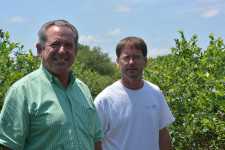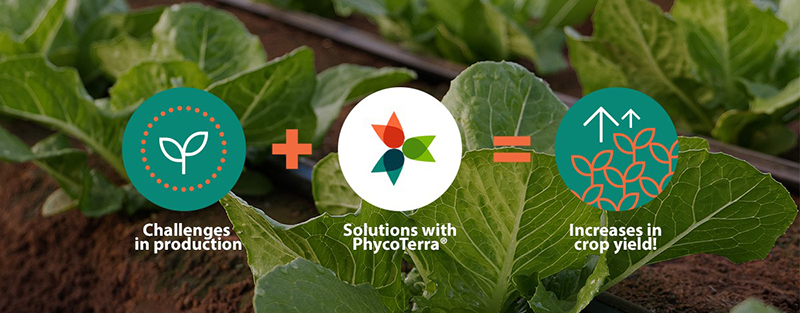Breaking New Ground With Blueberries

When a farm is in a family for nearly 100 years, there’s bound to be change necessary to keep up with moving landscape of Florida agriculture. The Lowe family farm near Groveland is no exception, having been established in 1918 with most of those years being in citrus.
“My wife Ann and I purchased her parents’ groves on the property here in 1987 and pushed the trees and replanted,� says Clinton Lowe. “They needed pushing after the freezes in the early ’80s. Well, guess what happened in 1989? Another freeze.�
Through the years, citrus has remained despite its challenges, but the onset of HLB brought a new threat and another reason to consider alternative crops. “We started researching blueberries as a possibility on some pasture land that we had purchased in 2003,� says Clinton. “We spent about 14 months researching, going to field days, and learning all we could about growing blueberries. We planted our original 5-acre block in February 2009.�
Lowe says doing your homework is critical to establishing a firm foundation before planting blueberries for the first time. “Once it is planted, there is not a whole lot of tweaking that you can do,� says Clinton’s son Dustin Lowe.
Now wrapping up its fourth season, the family’s Lake Catherine Blueberries is enjoying success as a commercial and U-Pick farm because of a well-planned foundation and planting.
While growing their first crop of blueberries, the Lowes pushed part of their remaining citrus grove and planted another 12 acres of blueberries in March 2010. “The main reason we pushed the grove was we already had an irrigation well and turbine on the land,� says Clinton. “That is a major expense of putting in blueberries for the first time.�
The Lowes are seriously considering replacing the remaining citrus grove with blueberries, despite the nostalgia. “We really wanted to keep the grove since it has been in the family so long,� Clinton adds. “But, greening is beginning to affect the grove, so blueberries might go in there as well.�
Blueberry Essentials
Blueberry planting remains on a popular growth curve in Florida, but it is crop that should not be entered into lightly. “The foundation needs to be laid correctly and that includes picking the proper varieties and making sure your fields are laid out correctly,� says Dustin. “You need to figure out how you are going to water these plants not just day-to-day irrigation, but also for freeze protection. And, you better have a plan for labor, because blueberries are very labor intensive and not just during harvest.�
“Running a blueberry farm is about like running a dairy in terms of the time and labor required, except we don’t have to deal with milk and manure,� says Clinton. “You have a lot of folks out there researching blueberries thinking they can plant a couple of acres and take care of them in their spare time. That isn’t going to happen.
“The serious grower should not go into blueberries with the mindset he or she can cut corners here and there. If you do that, your production will suffer.�
The Lowe’s production has been impressive, doubling the state average yield as a matter of routine. “You have to produce enough volume to justify the costs,� says Dustin. “We have 17 acres, which is not a heck of a lot of blueberries here in Florida, but it is enough. If you can get your production above 10,000 pounds per acre, then you can take advantage of some economies of scale.�
Emerald and Jewel are the two varieties planted on the farm. “In citrus terms, I’d equate these varieties to the Valencia and Hamlin of the blueberry world in this area,� says Dustin. “Emerald is a very hardy plant, is disease resistant, and it produces a big berry. Jewel is a heavy producer and comes in a little earlier than Emerald, but it is disease prone. Jewel is very finicky in the wrong kind of weather, while Emerald would keep producing if you set it on fire.�
Dustin says they won’t be planting any more Jewel, but are interested in some of the new varieties that have been developed by UF/IFAS. As new varieties come online, he says he’d like to see more trials planted in Central Florida to determine which ones fit best in the area. Much of the testing currently is either north in the Gainesville/Hawthorne area or south around Arcadia.
Yields are pushed higher through a comprehensive fertility program. In only the second season after planting, yields came in at 12,000 pounds per acre. The farm’s 2013 commercial harvest yielded 10,000 pounds per acre across the farm.
“We are very aggressive when it comes to our fertilization and pruning practices,� says Dustin. “We take quarterly soil samples and monthly leaf samples and are adjusting constantly based off what the samples are telling us.� The Lowes worked closely with Ryan Atwood, product representative for KeyPlex, in developing a micronutrient formulation specially designed for blueberry production called KeyPlex Blueberry DP. “We think the product has the right ratio of micronutrients for blueberries grown in a low pH environment. Virtually all acreage grown here in Florida is in pine bark. As it decomposes, it naturally releases manganese. In high doses, manganese stunts the plants, so the KeyPlex product takes it out of the mix. It has done a great job for us on these plants.�
The Power Of Social Media
Since the first harvest, the Lowes have opened their farm for U-Pick business and it has exceeded their expectations for success every succeeding season. Much of that success can be attributed to the networking potential of social media — and of course big, great-tasting berries.
Lake Catherine Blueberries Facebook page has nearly 5,000 fans and is very active during the season as those fans post pictures and tag the farm in posts. “During the season, all we really do is post a daily weather report,� says Dustin. “The rest of the activity is generated by our fans when they post pictures from their visits to the farm.�
Illustrating the power of Facebook to reach the masses, the Lowes purchased a $50 offer from Facebook to help promote the announcement of their grand opening of the U-Pick season this past April. The four-day promotion allowed the post to not only show up in the news feeds of fans of Lake Catherine’s Facebook page, but also in the news feed of all of those people’s friends. In addition, if one of those people liked the Lake Catherine page, it would then show up in the news feeds of all their friends.
“The opening day announcement post reached 32,000 people on Facebook,� says Dustin. “We had about 3,000 people come to the farm on our opening day. Facebook has been tremendous in helping us get the word out.�
[mmw-video id=”1617″]
Creating An Experience
“We are trying to create a family farm based experience that is more than folks just coming out to pick blueberries,� says Dustin. “On our opening day, we had a band, pony rides, face painting, balloon art, hay ride farm tours, and we served smoked chicken dinners.�
To add diversity to the U-Pick offerings, the Lowes will be planting blackberries and peaches on the farm in the coming year. “Our plan is to plant the blackberries and peaches next spring, so they should be coming online for U-Pick in two years,� says Clinton.
“Our motto is ‘From Our Farm To Your Family’ because we think consumers are educating themselves more about where their fruit and vegetables are coming from,� says Dustin. “We want to be on the forefront of that education process. When we have school groups and kids come out and visit here, I try to impress upon them that there is going to be great opportunities in agriculture in the future.�










